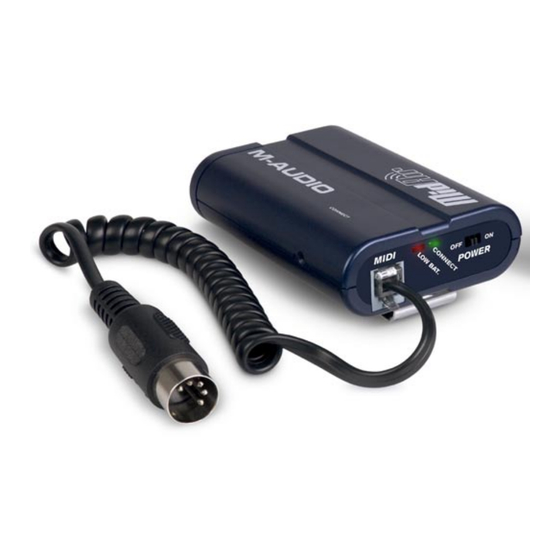Table of Contents
Advertisement
Quick Links
Advertisement
Table of Contents

Summary of Contents for M-Audio MidAir
-
Page 1: User Guide
Wireless USB MIDI System English User Guide... -
Page 2: Table Of Contents
MidAir Features ........ -
Page 3: Introduction
MidAir is your wireless MIDI solution. * MidAir is compatible with virtually all MIDI keyboards as well as other devices that have a MIDI output (such as drum machines and control surfaces). To simplify this User Guide, we refer to all of these wired MIDI devices collectively as “keyboards”... -
Page 4: Midair Features
MidAir technology extends this level of convenience to musicians working in the studio as well as performing on stage. MidAir establishes a one-way 2.4GHz wireless link and delivers a dependable MIDI connection at distances of up to 10 meters (30 feet). This proprietary linking technology constantly monitors the wireless signal and automatically changes frequencies when interference is detected, thereby ensuring a robust connection between the transmitter (keyboard) and the receiver. -
Page 5: Installation For Advanced Windows Xp Users
Installation for Advanced Windows XP Users he MidAir receiver is class compliant. This means that on Windows XP and Mac OS X computers, you can simply connect the receiver to the computer with a USB cable. The operating system already has the drivers required to communicate with the receiver. -
Page 6: Controls And Connectors
If you’re using more than one MidAir wireless setup, you might find yourself in a situation where you’ve inadvertently linked a transmitter to the wrong receiver unit. This will result in your MIDI data being routed to the wrong destination. -
Page 7: Receiver
10. MIDI In (In) – You can connect a MIDI device (such as a keyboard or electronic drum kit) to this input. Note that this input varies in function depending on whether your MidAir setup is in standalone mode or connected to a computer: Standalone mode –... - Page 8 MidAir User Guide 15. Standalone Mode Switch – This switch only affects the signal routing when using MidAir as a standalone (non- USB) device. It selects the source of the receiver’s MIDI output port. The Standalone Mode switch can be set in the following three ways: MIDI In –...
-
Page 9: Hardware Connections
MidAir User Guide Hardware Connections MidAir can be used in two basic configurations. Please take a look at the scenarios outlined below to find the one that best works for you. Scenario 1: MidAir as a Wireless, Host-Based Controller If you plan to use your MidAir system in a computer- based recording studio, this setup should best serve your needs. - Page 10 “Auto,” you can have a different MIDI controller connected to both MIDI inputs and use them subsequently without having to change the cable configuration or Standalone switch position. Keep in mind that the MidAir receiver never merges signals from the wired and wireless inputs. If MIDI is received on both the wired and wireless MIDI input port simultaneously, then the wired MIDI input will take precedence while any signals received at the wireless MIDI input port will be ignored.
-
Page 11: Troubleshooting
Troubleshooting MidAir is a professional-grade wireless MIDI system that has been tested under a wide variety of conditions. But in the event that you experience difficulty with your MidAir system, this section covers some common issues and tips to remedy these problems. - Page 12 To fix this problem, go to http://www.m-audio.com and search for this problem in the Knowledge Base. You will find a link to an executable (.exe) file that will solve this problem for you.
-
Page 13: Appendices
MidAir User Guide Appendices Appendix A: Useful MIDI Data Tables A1 - General MIDI Instruments – Program Change Numbers The following table lists all General MIDI patch names using numbers from 1 – 128. Please be advised that some GM modules count their sound patches from 0 –... - Page 14 MidAir User Guide A2 - General MIDI Note Numbers Octave Note Numbers A3 – General MIDI Drums – Note Assignments MIDI Note Drum Sound MIDI Note Drum Sound MIDI Note Drum Sound Acoustic Bass Drum Chinese Cymbal Cabasa Bass Drum 1...
-
Page 15: Appendix B: General Midi Controller Numbers (Midi Cc's)
MidAir User Guide Appendix B: General MIDI Controller Numbers (MIDI CC’s) Bank Select Gen Purpose 2 LSB Non-Reg Param LSB Modulation Gen Purpose 3 LSB Non-Reg Param MSB Breath Control Gen Purpose 4 LSB Reg Param LSB Controller 3 Controller 52... -
Page 16: Specifications
Warranty Registration Thank you for registering your new M-Audio product. Doing so immediately both entitles you to full warranty coverage and helps M-Audio develop and manufacture the finest quality products available. Register online at www.m-audio.com/register to receive FREE product updates and for the chance to win M-Audio giveaways. -
Page 17: Technical Information
© 2006 Avid Technology, Inc. All rights reserved. Product features, specifications, system requirements and availability are subject to change without notice. Avid, M-Audio and MidAir are either trademarks or registered trademarks of Avid Technology, Inc. All other trademarks contained herein are the property of their respective owners. -
Page 18: Contact Us
MidAir User Guide Contact Us M-Audio USA M-Audio Germany 5795 Martin Rd., Irwindale, CA 91706 Kuhallmand 34, D-74613 Ohringen, Germany Technical Support Technical Support web: www.m-audio.com/tech e-mail: support@m-audio.de tel (pro products): (626) 633-9055 +49 (0)7941 - 9870030 tel (consumer products):...











Need help?
Do you have a question about the MidAir and is the answer not in the manual?
Questions and answers